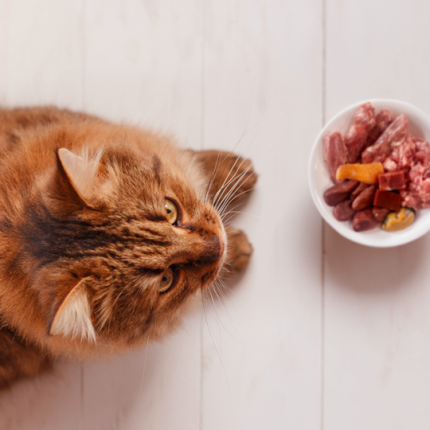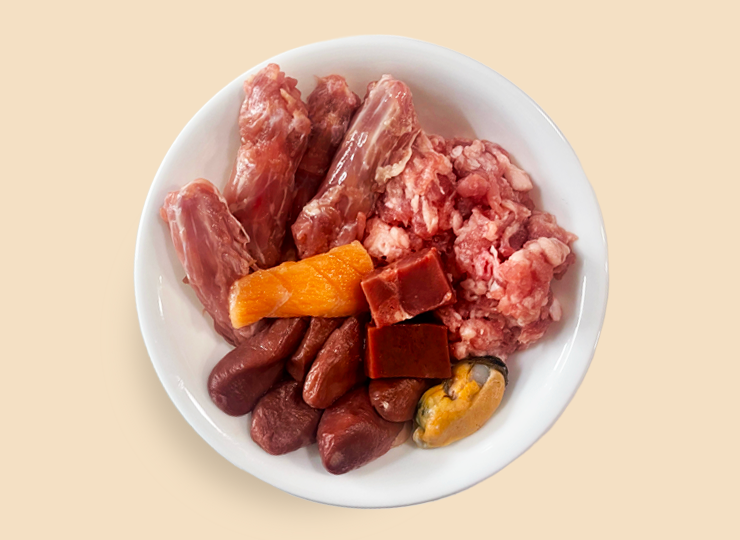DIY Raw Meal for Cats: Halloween-Themed Bowl

DIY Raw Meal for Cats: Halloween-Themed Bowl
For those who like to fully take the reins on their journey to Truly Raw, we’ve partnered with a certified pet nutritionist to create our DIY Raw Recipes series. These meals incorporate our DIY Parts products and other raw ingredients and are step-by-step recipes that you can follow to ensure you’re feeding your pet a complete and well-balanced raw meal.
For pet parents who prefer to spend time prepping DIY meals for their cat or kitten. This recipe is balanced to NRC nutritional guidelines for cats and kittens by our in-house certified canine nutritionist. The recipe is balanced as is and ingredient changes or substitutions can affect the balance of the recipe.
Batch Recipe Ingredients

- Carnos Chicken Necks – 1,750 g
- Carnos Chicken Hearts – 1,500 g
- Carnos Ground Boneless Pork – 2,050 g
- Carnos Salmon Chunk – 140 g
- Carnos Chicken Organ Mix – 140 g
- Carnos Beef Liver – 140 g
- Blue or Black Mussels, cooked – 140 g
- NOW Iron Bisglycinate, 18mg – 3 pills
- NOW Kelp powder – 5 scoops
- NOW Vitamin E dry capsules – 5 pills
Recipe total yield = 206 ounces = 12.9 pounds
Recipe calories per ounce = 48.3 kcal/ounce
Recipe macronutrients = 17.3% protein, 10% fat
Required Meal Prep Supplies
- Meal containers
- Adequate freezer space
- Cutting board
- Knife
- Kitchen food scale
- Large bowl or bussing bin
How to calculate appropriate feeding amounts for your pet.
A very general guideline for calculating feeding amounts:
Adult cats: adult cats of average size will typically consume 3-4 ounces per day. Very large cats will need slightly more. Adjust the feeding amounts as necessary to maintain a healthy body condition
Kittens: kittens should be allowed to eat as much as they can consume in a 10-15 minute period, a minimum of 4 times per day.
*Every cat is an individual with a unique metabolism. Feeding amounts should be adjusted as needed. If a cat is too thin and health issues have been ruled out, increase daily food. If a cat is too heavy and health conditions have been ruled out, decrease food within reason.
Meal Prep Instructions
- Calculate how many days the recipe will last your cat. This recipe should last the average cat 1 month. Set out the required amount of tupperware or food containers to hold meals. Food storage containers off Amazon in a 4 ounce size work great.
- Thaw frozen ingredients.
- Place chicken organ mix in a bowl and add the powder supplements (open and empty the capsules). Mix supplements in thoroughly
- Portion out ingredients into the meal containers
- Place 2-3 containers in the refrigerator and store the rest in the freezer. Remove 1 container from the freezer each day as 1 thawed container is used. Daily containers should be split into several meals per day.
Pro Tip: Cats can be difficult to transition to new foods. This is because cats have “food imprinting behavior”, which means that their brain will imprint on foods from a young age to help them identify foods that are “safe” for them to eat. Therefore, transitioning diets and trying new foods can take time and patience in order to show the cat that the new food is “safe”. Some cats will accept a small amount of new food mixed into their current food. If your cat will not accept that method, then try offering small amounts of the new food separate, but next to, their normal meal. When the food is presented next to safe food over time, cats will usually give the new food a try eventually. If your cat is starting on dry food, try slowly transitioning to wet food before transitioning to raw food.
Nutritionist Tip: Since cats are obligate carnivores, their diet does not need to include vegetables which provide fiber. However, wild cats would normally receive “fiber” through fur and feathers. Therefore, some cats may benefit from or need a fiber replacement; psyllium husk can work well for this.